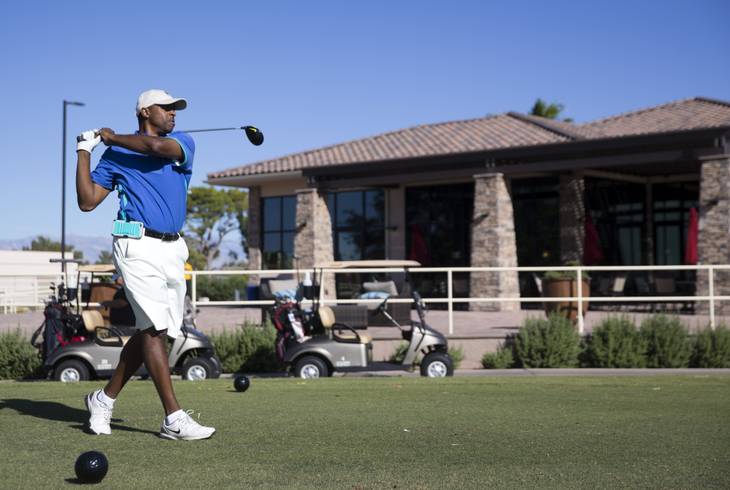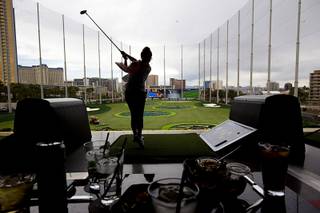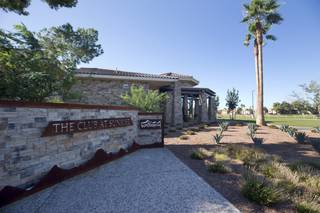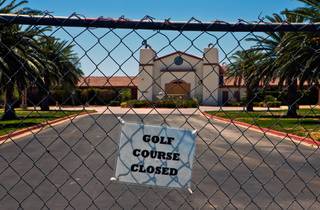It was a sweltering 106 degrees when Megan Mashore adjusted her stance under the shade of a Topgolf roofline. Music, chatter and the thwack of clubs smashing golf balls filled the air around her. In front of her, the Las Vegas Strip glittered.
“Just swing, right?” she said, eliciting chuckles from her husband, their two young boys and family friends.
It lacked the pretty arc of a Tiger Woods shot and didn’t register any points based on where it landed, but this was Mashore’s first time swinging a golf club. And she was far from alone in that respect.
Since Topgolf opened in May, the attraction — near MGM Grand on Koval Lane — has been a magnet for tourists and locals alike, the four-level property filling on weekends. Its 105,000 square feet boast more than 100 climate-controlled hitting bays, two pools, five bars, a concert area, private event space and, in true Las Vegas fashion, VIP cabanas and suites. The Topgolf game is a modern take on the classic, with players whacking microchipped balls at targets speckling a 240-yard outfield.
If visitor volume is any indication, the new attraction is a hit, especially among beginners. About 70 percent of Topgolf guests describe themselves as non-golfers, and the Las Vegas flagship expects 1 million visitors in its first year, said Adrienne Chance, director of corporate communications.
That raises a question about Southern Nevada’s golf industry: Will the new attraction’s popularity parlay into renewed enthusiasm for traditional courses? After all, newbies like Mashore represent a potential customer base.
“It’s kind of like bowling meets golf,” she said while resting on the bay’s plush couch. “I think it’s an introduction to golf in a not-so-intimidating way.”
Post-recession golf economy
Across town, with sprinklers watering fairways in the distance, several men practiced putting. Nearby, instructors taught young boys and girls the fundamentals of golf as caddies toted clubs to and from the parking lot.
This was the backdrop for a news conference at The Club at Sunrise, a recently reopened golf course in the east valley.
Floodwaters tore through the county-owned property near Sahara Avenue and Nellis Boulevard — then called Desert Rose — in September 2012, damaging adjacent homes and killing a landscaper. The situation prompted a $150 million flood-control project and extensive renovations to the course.
County officials said they never considered getting rid of it, partly because neighbors strongly favored retaining the green space. It’s viewed as a county amenity in the same vein as soccer and baseball fields, said Jane Pike, director of parks and recreation. And it’s an anomaly in Southern Nevada: In a market golf experts largely describe as overbuilt, it’s a rare example of a course getting a second chance.
Officials hope the $39 rate for 18 holes, with a $10 food credit, offers more incentive for potential golfers.
“It’s extremely important to keep a viable golf course that’s affordable to community members in this area,” Pike said.
The local golf market has withered from its ’90s heyday, when the population was soaring and bulldozers were busy grading desert land for pristinely landscaped, opulent courses.
Just as the recession toppled the local housing and construction markets, it strained golf courses reliant on discretionary income. Shrinking income stunted travel — affecting the pool of golf-playing tourists — and caused locals to close their wallets. Add astronomical water costs to the equation, and the financial strain on regional courses was heavy.
Golf course owners reacted by reining in expenses, whether it was watering less, cutting some services or reducing landscaping efforts, said Christopher Cain, director of UNLV’s PGA Golf Management Program.
To survive, “golf operators had to get real lean and mean,” said Jeff Woolson, managing director of CBRE golf and resort properties.
Time has healed some recession-generated wounds, but golf experts largely agree it isn’t the thriving business it once was in Las Vegas.
And it’s not just a Las Vegas problem. Golf participation in the U.S. declined from 30 million people in 2005 to 24.1 million last year, according to the National Golf Foundation. The waning interest could be attributed to a number of factors, including its cost, perception as an exclusive sport and millennials’ preference for quicker, more action-packed entertainment.
“I think we’re at a balancing point,” Cain said. “There may be a couple of properties that we may lose to development, and, if we do, that’s what the market decides.”
Greens vs. green
Southern Nevada is home to roughly 60 golf courses, the majority of which have public access. The only new course on the horizon is part of a luxury real estate project in Summerlin.
If construction equipment arrives on other courses, it will likely be for redevelopment.
Last year, developer EHB Cos. bought the Badlands Golf Club, nestled among the Queensridge neighborhood near Alta Drive and Rampart Boulevard. EHB is behind several well-known projects in that area, including One Queensridge Place and Tivoli Village. Shortly after purchasing the course, developers unveiled plans to turn the acreage into estate lots and luxury multi-family dwellings, outlining their rationale in a letter sent to the city of Las Vegas in February.
It cited the state of the course, deferred maintenance and water costs, drought conditions, significant decline in golfers and green fees and an oversupply of courses. EHB seeks major modifications to the area’s master plan as well as zoning changes, which would allow redevelopment to move forward.
“The golf course is going away,” the letter states. “It cannot reasonably be saved by the Applicants or by anyone else for that matter.”
Even so, neighbors have been protesting the proposal for months. They earned a small victory in early July when the city planning commission delayed a decision until October.
It’s not an isolated tale. The owners of Silverstone Golf Club shut down the northwest valley course after purchasing it last year. And the owners of Royal Links Golf Club, just south of The Club at Sunrise, want to convert that land into housing. They say if it were zoned residential, the $13.5 million value would shoot up to $24.2 million.
Meanwhile, Steve Wynn has proposed redeveloping much of the golf course behind his Strip resorts into a 38-acre lagoon complex called Paradise Park, set up for water-recreation activities and surrounded by a white sand beach, a boardwalk, restaurants and a new hotel tower.
Other courses are on the market or in the midst of a sale, including the nostalgic Las Vegas Country Club. The private club’s members are entertaining multiple offers for the property, which will remain a golf course, said Woolson, one of the brokers. He doesn’t expect a deal to be finalized for a few months.
Golf courses have been selling for $4 million to $12 million in the Las Vegas Valley, he said. “If there’s any other use besides a golf course, I think it’s worth more.”
Looking forward
The clubhouse at DragonRidge Country Club in Henderson is undergoing a massive facelift. Bars, restaurants, patio space, the pro shop and even the ballroom will have a more contemporary look come September.
It’s part of a push by owner Rich MacDonald, who developed the course and surrounding MacDonald Highlands neighborhood, to revitalize golf and shed any “stodgy, old-fashioned” feel. That starts at the clubhouse.
“We want it to be the social hub of the community,” he said. “We want this to be the place where you bring your friends.”
This year, MacDonald purchased the course from Pacific Links International, the same company he sold it to two years ago. Now that he’s back in the golf business, MacDonald is optimistic the game has a good lifespan as long as clubs focus on modernization, with an eye toward involving more children and families.
DragonRidge recently hired an activities director to do just that. The club hosted a Fourth of July event, featuring fireworks and a live band, and has happy hours planned.
The strategy mirrors what the gaming industry has done on the Las Vegas Strip: With fewer millennials gambling, resorts have diversified entertainment, hence the proliferation of nightclubs, pool parties and concert venues. To get the younger generation in the door, golf club owners are getting similarly creative.
They’re also teaming up to revive junior golf programs. A “Youth on Course” program allows golfers ages 8 to 18 to play at 22 local courses for no more than $5 per game.
“What we’ve done is reduced the barrier to entry with access,” said Eric Dutt, president of the Nevada Golf Course Owners Association and vice president of golf operations for Caesars Entertainment. “Kids have a place to play and practice with this program. We’re trying to create the next generation of golfers.”
Dutt and MacDonald expressed hope that Topgolf could be another gateway, perhaps among slightly older golfers. (Fifty-four percent of Topgolfers are between 18 and 34 years old, according to company data.) They theorize when Topgolf guests desire a new challenge, they’ll be more likely to try a traditional course.
Golf 20/20, a group focusing on the sport’s future vitality, released a report in December examining how “alternative golf experiences,” like Topgolf, affect the traditional game. The task force found that 30 to 50 percent of non-golfers playing in alternative golf games were interested in playing the traditional game, compared with 11 percent of the general non-golfer population.
“It’s a good thing,” MacDonald said of Topgolf’s presence. “It gives people a chance to go out and hit some balls and get the feel for it.”
Tourists remain the question mark. Given Topgolf’s proximity to the Strip, it draws many patrons who may have little or no interest in exploring Las Vegas golf courses.
Only 2 percent of respondents in the 2015 Las Vegas Visitor Profile survey said they played golf here, according to the Las Vegas Convention and Visitors Authority. By comparison, 7 percent of those surveyed visited a spa.
“(Las Vegas) is not a golf destination,” Dutt said. “It’s a very impulsive market where we’ll get convention folks or people who have a free half a day and decide to play.”
That’s why it’s critical golf course owners continue bolstering youth programs, services and entertainment offerings, he said. Clubs nationwide are looking at providing perks like daycare and business centers as well as lighthearted nine-hole events and “wine and dine” nights, which might bring in more women and younger people.
“It’s almost like the Walmart offer,” Dutt said. “How do I offer five or six things until you say I’m going to take advantage of one?”




